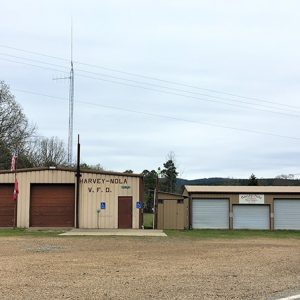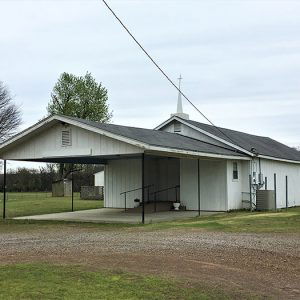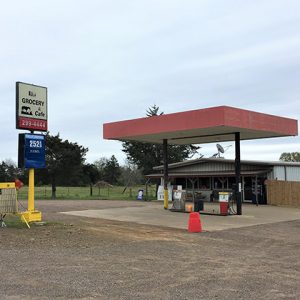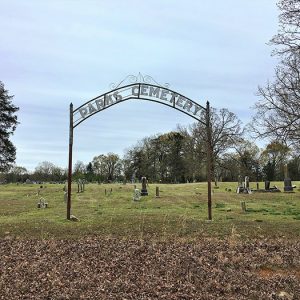calsfoundation@cals.org
Nola (Scott County)
Nola formed as a small farming town in eastern Scott County. The unincorporated community was established within the Fourche La Fave River valley near the Yell County border. It is located near Harvey (Scott County), just two miles west along Highway 28. The area where Nola and Harvey are now located was once known as Nebraska.
Prior to European exploration, the area where Nola is located was lush with native vegetation and wildlife. Archaeological evidence from the Archaic, Woodland, and Mississippian periods indicate that native people long lived along the river valley where Nola is located. Native American people of the Caddo tribe began settling along the valley around AD 1000. Several thousand burial mounds and other archaeological sites are located throughout the Fourche La Fave River valley.
Spanish explorer Hernando de Soto is credited with being the first European to explore Scott County. It is probable that his journey from Washington County to Hot Springs (Garland County) led his expedition through the area where Nola is located. During the late seventeenth and early eighteenth centuries, French hunters and tradesmen explored the waters of the Fourche La Fave River and other tributaries of the Arkansas River. It is likely that they traversed the waters of the Fourche La Fave near Nola.
Prior to the Civil War, there were few families living in the area. The Jones and Parks families were some of the first to settle in Nola. Will Parks was a merchant from Georgia who became a prominent landowner. The Parks family donated land for a cemetery in Nola, which was subsequently named after them. Land for the cemetery was donated in 1836, though the oldest inscribed tombstone dates to 1860.
After the Civil War, there was an influx of families moving to Scott County, with some settling near present-day Nola. The Kelley family was one of the first. Jerry Kelley and his sons owned and operated a store between present-day Harvey and Nola. The Kelleys were also known throughout the state for the quality of their horses.
Nola continued to grow in the late nineteenth century. The Harris family operated a store and cotton gin on its property. The Hall family moved to Nola in 1871 and stayed until 1876. The eldest Hall son worked for J. M. Caviness, making molasses. The Hall family also farmed land owned by Francis Marion Monroe of Harvey. It is possible that the community was named after the daughter of James and Rebecca Kelley, Nola Kelley, who married James Monroe of Harvey.
In May 1882, the Scott County Courthouse burned, destroying all records that defined the boundaries of the various school districts that had been established throughout the county. Several months later in August, the county court reestablished the boundaries of the fifty-six school districts active in the county; however, the Nola School District, No. 2, was created years later in 1908. Prior to then, School District No. 2 was known as Little Star, which was established as early as 1871.
Nola was a thriving community in the early twentieth century; however it did not receive its first post office until 1907. Among the prominent families in Nola were the Wagners. Bob Wagner was known for his musical talents, and he organized and managed several Christian quartets in the Stamps-Baxter style, eventually developing his own quartet. His programs aired on KTHS in Hot Springs, KFPW in Fort Smith (Sebastian County), KTUL (Tulsa, Oklahoma), and KOLS (Pryor, Oklahoma).
Several members of the Nola community were drafted during World War II. By the mid-twentieth century, Nola had begun to decline as a result of business and school closures in the area. By 1954, the Nola School District was reformed as Fourche Valley and located in Yell County. The Nola post office was discontinued in 1959.
Nola is one of the few unincorporated communities in the Scott County that still has an operational business in the twenty-first century. The Nola Grocery and Café is a popular place for locals to eat lunch and acquire grocery items. It also serves as a convenience store and gas station for hunters and other visitors traveling to the Ouachita National Forest. Many members of the Nola community attend the Nola Church of Christ, which is the only religious institution in the community. Nola is served by the Harvey-Nola Volunteer Fire Department.
For additional information:
Cate, Michael. History of Scott County, Arkansas. Dallas, TX: Curtis Media Corporation, 1991.
Echoes: The Scott County Historical and Genealogical Society Quarterly. Waldron, AR: Scott County Historical and Genealogical Society (1986–).
Goodner, Charles. Scott County in Retrospect. Mansfield, AR: Frank Boyd, 1976.
Goodner, Norman. A History of Scott County, Arkansas. Siloam Springs, AR: Bar D Press, 1941.
McCutcheon, Henry Grady. History of Scott County, Arkansas. Little Rock: H. G. Pugh and Company, 1922.
Ty Richardson
Richardson Preservation Consulting
 Harvey-Nola Fire Department
Harvey-Nola Fire Department  Nola Church of Christ
Nola Church of Christ  Nola Grocery and Cafe
Nola Grocery and Cafe  Parks Cemetery
Parks Cemetery  Scott County Map
Scott County Map 



Comments
No comments on this entry yet.